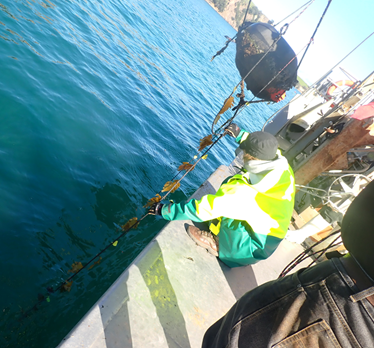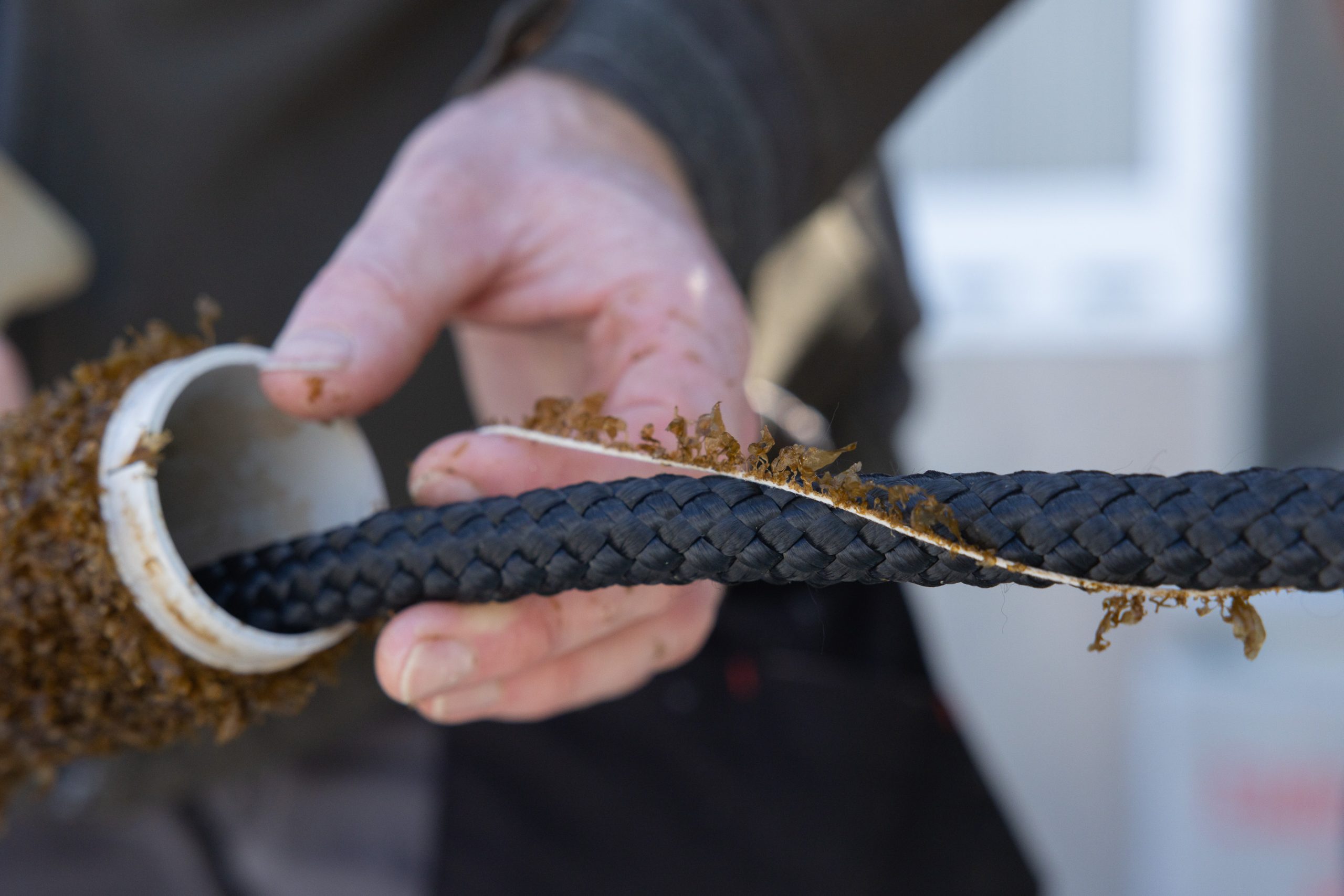
GreenWave Aotearoa is an innovative three-year regenerative ocean farming pilot that began in mid-2021. Led by EnviroStrat, in partnership with Ngāi Tai ki Tamaki,Premium Seas Ltd, the Universities of Waikato and Auckland and AgriSea, the $5 million pilot is focused on creating an economically viable seed-to-harvest model for seaweed farming inNew Zealand. Taking place on existing consented aquaculturefarm sites in the Hauraki Gulf, supported by hatcheries in the Coromandel and Tauranga, the pilot is developing on-water infrastructure and growing techniques, post-harvesting logistics and product development. In doing so, GreenWave Aotearoa seeks to optimise productivity (and therefore commercial viability) of seaweed farming and provide the impetus for scaling the farming of native seaweed at a commercial scale.
In the past five years there has been a surge in interest, both globally and domestically, in seaweed. Seaweed farming is emerging as an opportunity to leverage existing marine farming skill-sets and traditions to provide meaningful economic, environmental, social and cultural benefits to local communities.
Seaweed makes up almost a third of global aquaculture production volume.The global value of seaweed aquaculture in 2019 was estimated at US$14 billion with a growth rate of 7% per year on average over the last decade. Seaweed aquaculture production volume has tripled over the last 20 years and now accounts for 97% of total global production – over 34 million tonnes was aquaculture and just over 1 million tonnes was wild harvest in 2019.
(Reference: Fishery Statistical Collections. Global aquaculture production 1950-2019 (FishStatJ). Retrieved April 28, 2021, from http://www.fao.org/fishery/statistics/global-aquaculture-production/query/en and http://www.fao.org/fishery/statistics/software/fishstatj/en )
While currently operating at small scale, with numerous new initiatives and businesses targeting seaweed as a novel primary resource, it has huge potential for New Zealand’s blue economy. Gaps and barriers are currently limiting the sector’s ability to grow and as a result it is not realising its potential, or keeping pace with international developments.
It was against this backdrop that EnviroStrat first became aware of GreenWave and the philosophy that underpins its regenerative ocean farming model.
“I really liked what I was reading and seeing about GreenWave,” says Nigel Bradly, EnviroStrat CEO. “Multi-species regenerative ocean farming has the structural underpinnings of resilient ecosystems and economics, bringing together positive social and climate impacts while still enabling profitable business at a local community level.”
While attending the UN Ocean’s Week in New York in early 2019, Nigel was introduced to Kendall Barbery, GreenWave Programs Director. Off the back of that introduction, Nigel made contact to discuss assessing the feasibility of adapting the model for a New Zealand context.
With agreement from GreenWave to collaborate, and support from Auckland Council, EnviroStrat prepared a feasibility study, taking a consistent and structured approach to looking at the project. “We asked ourselves what it would take to adapt the GreenWave model for New Zealand, taking into account our different regulatory systems, bicultural context, climate, market and species” says Nigel.
The feasibility study helped EnviroStrat hone in on the one part of the puzzle that was most absent – seaweed. “We don’t need to learn how to farm mussels and oysters; we do that really well in New Zealand already, but we don’t farm seaweed, so that needed to be the focus for initial development of regenerative ocean farming here” says Nigel. “That doesn’t mean that in the future we won’t add other species, but the feasibility study helped us realise there’s no point trying to adapt GreenWave in New Zealand until we can establish a functioning supply chain for seaweed.”
The feasibility study helped us to get a greater understanding of the potential market for GreenWave grown products. “We realised that if the GreenWave regenerative ocean farming model was to succeed in New Zealand, it wouldn’t be reliant on the local restaurant market as it is in other parts of the world, due to the relatively small scale in Auckland” says Nigel.
With the focus moving specifically to seaweed EnviroStrat undertook detailed analysis to make a case for investing in establishing a seaweed supply chain. Currently there is no structured supply chain for seaweed biomass. Local companies who process seaweed for soil, plant and animal nutrition or biomaterials and human health, rely on seaweed washed up on shore or sourced from mussel line bycatch.
Although there is a lot of knowledge to draw from internationally, there is very little experience or understanding of how to farm seaweed in New Zealand. This meant the investment case needed to get down to a greater level of detail of how hatcheries, seeding, outplanting and harvesting protocols and farm design would be developed and tested for our local species and conditions, to make the case for investing in the establishment of a supply chain for seaweed.
With investment secured from the Sustainable Food and Fibre Futures Fund, administered by the Ministry of Primary Industries, impact investors and philanthropic organisations to bolster EnviroStrat’s own investment, the Greenwave Aotearoa pilot was mobilised in mid-2021 .
“When thinking about the pilot we never pretended that we could do it alone,” says Nigel. “To help move us from a community of passion to a community of practice, EnviroStrat has aligned with organisations that are both value-aligned, and have capability and experience in areas that we don’t. The contribution of the wider team’s skills and expertise enables us to blend operational, science and commercial experience, ensuring that commercial seaweed farming will be a part of New Zealand’s blue economy future.”
Lucas Evans from Premium Seas is facilitating access to water space, the Coromandel hatchery and providing operational oversight for the pilot delivery.
Working with iwi is at the heart of the pilot. Ngāi Tai ki Tāmaki are providing recently consented marine farming space to support the pilot and are part of the pilot steering committee.
University of Waikato researchers Dr Marie Magnusson and Dr Rebecca Lawton are overseeing the research and trial design.
Professor Andrew Jeffs at University of Auckland is leading monitoring to establish the biodiversity impacts of co-locating mussels and seaweed farming.
ArgiSea is contributing its post-harvest production, market and processing expertise.
“In developing this concept we’re clearly saying there is a strong beneficial impact that can be achieved – environmentally, socially, economically and culturally,” says Nigel. “Our philosophy is not just finding a new way to establish a supply chain for seaweed, but focusing a lens on how to maximise positive impacts associated with regenerative ocean farming.”
EnviroStrat is developing an impact framework that will help understand the impact of the pilot and potential longer term impact. The pilot will measure the potential environmental impacts, including increasing marine biodiversity, improving water quality through the uptake of nutrients, carbon sequestration, and will examine the potential for seaweed to contribute to coastal protection, as well as understanding social, economic, and cultural impacts.
“Seaweed is an emerging sector in New Zealand, poised to move forward quickly. It’s an exciting journey.”


